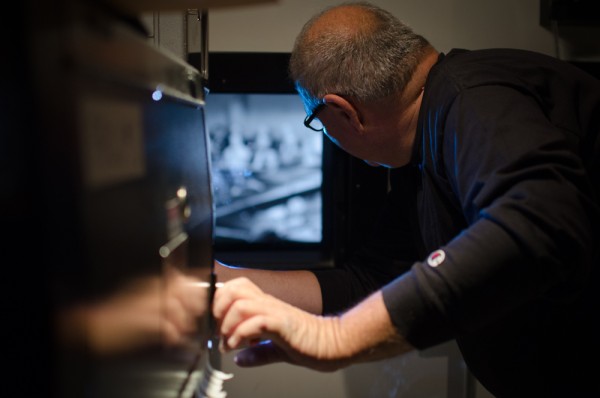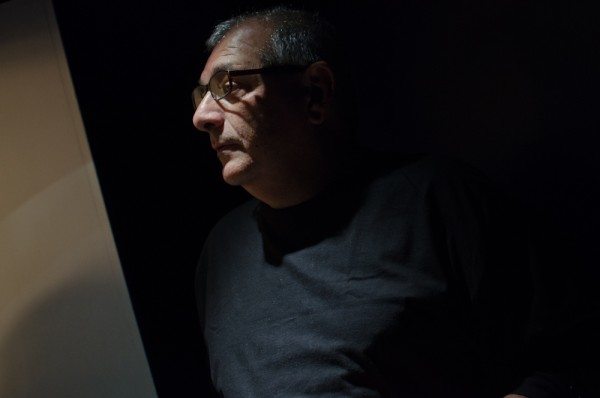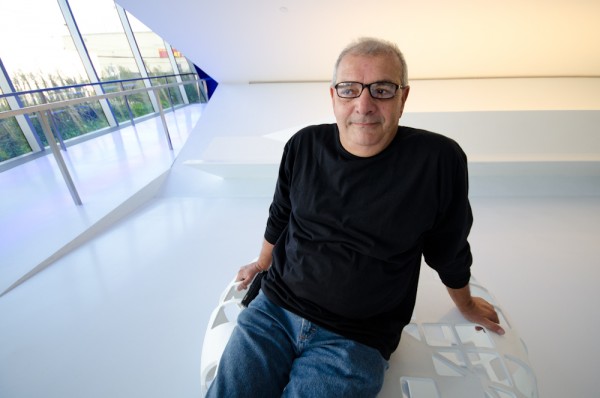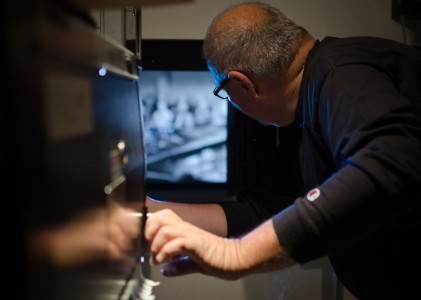Master of a Dying Art
This article, originally published on the website Narratively in 2012, is a portrait of the Museum of the Moving Image's beloved chief projectionist, Richard Aidala, who died on August 20, 2013. Aidala worked at the Museum since opening day in 1988, and was a master of a fading art, the projection of celluloid film. Daphnée Davis's portrait of Richie is also a portrait of the changing world of film projection as it enters the digital age. Due to some technical inaccuracies in this article, we have published corrections verified by Museum of the Moving Image's projectionist as numbered comments below.
Back in the days when most films were beamed onto screens
from rolling projection reels, Richard Aidala absolutely hated going to the
movies. After the lights went down, he found himself unable to pay attention to
the plot, and could barely stand to look at the images in front of him. All he
saw were mistakes. What was that reflection on the screen? Wasn’t the focus
off? And what was going on with those lamps? The lamps needed to be realigned!
“I complained so much that nobody in my family would go to the cinema with me,”
he says now, exploding into a characteristic burst of rowdy laughter.

Richard Aidala
But Aidala, a graying 62-year-old with bushy eyebrows, a sharp nose, and a
perpetual grin, is no cinema buff. In fact, he has absolutely no interest in
the craft of filmmaking. All he cares about is how films are shown.
Professionally, Aidala has done one thing for 40 years: show moving images
in theaters. Before cinemas switched to digital projectors, before films could
fit on a hard drive, before most of his peers lost their jobs, he worked the
reels in dark rooms, perched high above New York City’s movie-going public.
Aidala, who first started working in theaters at the age of 20, is now the
chief projectionist at the Museum of the Moving Image in Queens, where he
gratifies a never-ending stream of cinephiles, or Cinemaniacs, as a 2003
documentary about film buffs christened them.
In the world of film, where writers, directors, cinematographers, and, of
course, actors, are placed on a pedestal, the public has long overlooked the
importance of the projectionist—the single person who, at least at one time,
had absolute control over your viewing experience. But the lack of recognition—the
anonymity offered by this post—is just fine with Aidala, who, despite an
imposing physical presence, is most comfortable slipping into the background.
“A good projectionist should be invisible,” he says, his small rectangular
glasses steadied on his forehead. “No one should be able to tell you’re in the
booth changing the reels.”
Today, no one does. The reels have become obsolete, and, increasingly, so has
the projectionist. Aidala still has a job because he’s lucky enough to work at
a museum of cinema, one of the few places in the country where his knowledge
remains relevant.
He’s the master of a dying art, a curator of nostalgia.
***
In the 1940s and ’50s, the heyday of reel-to-reel cinema, Local 306, New York
City’s projectionist union, was 3,500-people strong. Now one of the last
single-trade unions in the country, it barely registers a hundred members.
“We’re dinosaurs,” Aidala says, looking over his shoulder at one of his
colleagues, Hunter Webb, on a recent Saturday afternoon at the museum.
The dimly lit projection room where the two men work contrasts with the
immaculate lobby of the Museum of the Moving Image, a hall surrounded by large
windowpanes and bathed in daylight. Instead of posters, images from on-site
exhibitions are projected onto the white walls of the museum, whose futuristic
design makes clear that it celebrates both old movies and film innovation. As
such, it is one of the only places where digital and reel-to-reel projectors
still cohabitate.
On weekends, the museum has multiple screenings simultaneously and needs four
projectionists on hand. But on weekdays, there’s only enough work for one of
them.
Aidala has manned the museum’s projection booth since it opened 24 years ago.
As the longest-serving projectionist at one of the country’s most venerable
film institutions, he is widely regarded as among the most
knowledgeable in his field.

Richard Aidala
On this day, though, he isn’t running the show. Webb, standing nearby, is
operating the projector for today’s retrospective. The 42-year-old gets busy
behind the reels, his long, dark hair gathered in a messy ponytail so it
doesn’t get in the way. As Webb runs a print of Michelangelo Antonioni’s short
film L’Amorosa Menzogna, Aidala eats a lunch of fries and a hamburger, seated
among dozens of film prints stacked in metal cases. The heavy canisters are
meant to protect celluloid film and keep it away from too much light, though
prints occasionally arrive at the museum damaged or even shredded.
Today’s screening is a complicated one, Aidala explains, as it includes a dozen
Antonioni shorts spanning the prolific Italian filmmaker’s half-century career.
Each is in a different format, reflecting the evolution of the industry and its
standards since Antonioni began his eclectic career in 1942. Some of his shorts
are on VHS [1] tape, others on DVD, and others, still, on 35-millimeter prints.
After running the print of L’Amorosa, Webb abandons the projector to operate
a VCR[2], then starts spooling film on a reel, preparing for the next showing.
Since about 1895, movies were printed on five-foot-wide reels of 35-millimetre
film, then laced onto the rolling spools [3] of a projector. Now, they’re computer
files [4] that don’t need rolling to be beamed onto a screen.
When Aidala’s at the movies himself—which happens only rarely, since he,
ironically enough, prefers television—he can relax and get immersed in the clean,
digital experience; his impulse to watch out for defects lies dormant.
Professionally, however, the transition from film has left many projectionists
like Aidala out of work. Increasingly, the job requires nothing more than
plugging in a hard drive [5]. Though he regrets that many of his former colleagues
have been rendered obsolete, Aidala surprisingly does not lament the old days;
he unabashedly dismisses those who say vintage reels are better than flawless
digital copies.
“I prefer digital, definitely,” Aidala admits, sitting at his desk overlooking
the museum’s 250-seat [6] theater on a recent weekday afternoon. “Digital is 99.9
percent as good as pristine 35-millimeter print.” The intimate experience of
screening a crisp print is undeniable, he says, but digital screenings are so
hands-off that there’s less margin for error.
One early spring weekend, the museum screens a 24-hour static shot of the
Wilshire Federal Building in Los Angeles, a piece by conceptual artist Mary
Ellen Carroll—“a crazy woman,” Aidala says, rolling his eyes. The film, unlike
many others that Aidala shows at the museum, is digital. He chooses the
lighting, makes sure the shot isn’t out of frame, and then waits. And waits.
He’s there only to make sure nothing goes wrong. It’s a long, empty, workday.
***
“It used to be such a labor-intensive job,” recalls Joseph Rivierzo, an
executive board member of Local 306, the projectionists union, whose father and
grandfather preceded him in the craft.
Rivierzo, a skinny but strong Italian-American, started helping his father
behind the reels in 1970, when he was just twelve years old. In those days,
“moving picture machine operators,” as they were officially known, would crank
a huge bobbin of silent film while a pianist accompanied the images.
When the reels became automated, in the late ’60s, projectionists no longer
manually rolled them, but still changed from one 35-millimeter reel to the next
every twenty minutes [7]. The screens were lit by carbon-arc lights [8] that were
consumed after one screening 99]. As technology developed, spinning platters allowed a whole movie to be spliced together into one large reel eliminating changeovers, and longer-lasting Xenon bulbs eliminated the need to replace lamps after every screening. Theaters opened
several screening rooms because one projectionist was suddenly able to handle
ten different screens. Salaries rose, but for Rivierzo the switch marked the
beginning of the end. “It was a controlled retreat,” he says.
The digital revolution, however, was slow to take hold of the cinema industry.
While dematerialized music appeared in the late ’90s, digital film took longer,
partly because the logistics of the technology were harder to navigate. Just
one frame of film takes up more digital space on a computer than an MP3 sound
file, for example.
Still, the time finally came. The first major change occurred a little over a
decade ago when film manufacturers and producers began subsidizing the purchase
of digital projectors. They were eager to cut their costs by shipping digital
copies instead of 35-milimeter reels encased in heavy canisters. Then came the
so-called "Avatar" effect; the rush to produce 3-D movies, which demand costly
digital gear, tipped the scales for good once James Cameron’s sci-fi epic
became the highest-grossing movie of all-time, in 2009.
In the past three years, almost all of New York’s cinemas that hadn’t already
gone digital have since made the transition. Even the iconic 1,169-seat Ziegfield
Theatre, the largest single-screen venue in Manhattan—and one of the few that
has bucked the trend of breaking down into smaller theaters in order to show
more films—has made the switch. It is now owned by Clearview Cinemas.
“When I was in my twenties, screens were the size of a football pitch,” Aidala
recalls with delight. “Now, they’re so much smaller—a multiplex has up to
fifteen screens.” The only theaters that still need fully qualified
projectionists are a few dingy ones that can’t afford to buy new projectors,
and museums and niche locations like the Film Society of Lincoln Center or the
Museum of the Moving Image, which show older movies in the format
in which they were originally produced.
Skilled projectionists are still in high demand at film festivals, where using
a professional craftsman means improving the quality of the show. A career
projectionist, after all, knows the amount of lighting a movie screen needs and
always makes sure the image fits the frame. While commercial venues may be
inclined to cut costs and get managers to oversee their screenings, movie
professionals still insist on getting a perfect image.
“I can ruin the most talented director’s work with a poor showing,” Aidala
says.
Sadly, a few film festival premieres are not enough to support an industry that
is taking its last breaths. In recent years, Local 306 has struggled to provide
the Tribeca Film Festival with projectionists because there are so few left
working. Sometimes, Rivierzo says, the union even has to ask retirees to fill
in because there’s no one else who knows how to man the reels. But Richard
Aidala’s generation won’t live forever.

Richard Aidala
The Museum of the Moving Image’s main projection booth is, like most, stripped
of unnecessary comforts. The dark, wide room is merely equipped with a bathroom
and a black microwave atop a fridge. Six cans of Coke line a glass window
overlooking the auditorium. Other personal details are scarce, aside from
Aidala’s desktop screensaver, a photograph of himself and Carolyn Funk, a
younger colleague. The booth is filled with dozens of 2,000-foot reels of film.
Four projectors—two 35mm, one digital, one 16mm—sit in the middle of the
white room where eight small windows overlook the main theater. Here, Aidala
has shown the same print of Charlie Chaplin’s The Immigrant several times a week
for the last fifteen years. A Museum pianist always plays as the silent film
rolls, just as in earlier times when there was no soundtrack. “Silent movies
were never silent,” Aidala says in his thick New York accent.
A Brooklyn native, he started working in the industry long after sound had
entered the picture (which, by the way, destroyed the experience, according to
some purists). Unlike many projectionists who followed their fathers into the
profession, Aidala fell into it while working for the military. The Navy used
to lease the rights to a movie for four years and send the prints to deployed
Sailors. At eighteen, after graduating from the New York Institute of
Technology, Aidala got a civilian job with the Army unloading the prints from
trucks. Back then, a Navy captain, whose name now escapes Aidala, would watch
private screenings of Hollywood movies at the Brooklyn Navy Yard and select the
best ones to send to the troops. When the official projectionist took a leave
of absence, Aidala filled in for him. And when that same projectionist retired,
in 1970, the then-twenty-year-old Aidala got his own show.
When he joined the projectionists’ union, at 21, Aidala had to take an exam to
earn his New York City projectionists’ license. Candidates were required to
answer one hundred questions and pass a practical test to demonstrate that they
were able to work the reels of a theater. As a matter of safety, movie
operators also needed to prove they could deal with floods and fires,
considering that they worked with highly inflammable nitrate film.
Aidala started working at various cinemas around New York, and then became a regular projectionist at what was
then the Saint Mark’s Theatre, in the East Village. One fateful afternoon in
1977, he arrived at the theater, on Second Avenue and Saint Mark’s Place, to
find a padlock on the door; the owner had gone bankrupt. That same day, Aidala
struck a deal with the landlord and began running the cinema himself.
The newly-minted theater owner, along with two partners, made the
four-hundred-seat single-screen cinema a success.
“We were sold out every single night,” Aidala remembers. Two years later, they
opened another location in Park Slope, this time with two screens. Film
students from New York University worked for them as ushers to get deals on
screenings; one, Jim Jarmusch, would go on to become a celebrated independent-film
director.
Through the ’80s, theater owners made decent money, though Aidala describes the
business back then as a “glorified candy store,” because most earnings came
from refreshments. That shouldn’t have bothered him, however: his long-time
dream had been to open a restaurant, which is why he abandoned movies in 1982.
But less than four years, his restaurant went bust and he was back behind the
projector.
Then 36, Aidala found a job at the Columbia Pictures screening room in Astoria,
Queens, near where the Museum of the Moving Image was being built. Every lunch
break, Aidala took his sandwich to the construction site. “I wanted to work
here so bad,” he says.
Working at a production company, Aidala only showed movies on demand to small
groups invited to the screening room. He craved interaction with larger crowds
and the challenge of showing older movies. The museum hired him as one of its
first projectionists, even before opening to the public in 1988. Though he
couldn’t have known it at the time, it was the best career move Aidala could
have made.
In 1990, he married and moved to Matamoras, a small Pennsylvania town, where he
raised three daughters. Ever since, he’s been waking up at 4:30 a.m. four times
a week for the two-hour drive to Queens. “It’s insane, I know,” he says. “With
the gasoline prices, I may even be losing money coming to work.” Still,
Aidala’s never questioned whether he should find a job closer to home. The
museum suits him, he says.
Over the years, even as Aidala continued to learn new projection techniques,
his knowledge lost market value, and relevancy. “It’s basically a useless art,”
he admits today. Getting a projection license has become so simple that what
used to be a complicated practical test—for a technologically-demanding job—has
become a formality, Rivierzo says. Theater managers have replaced his peers in
most projection booths across New York and beyond.
***
Aidala’s day-to-day routine at the museum varies. A hands-on celluloid film
screening may be followed by the projection of a simple DVD. In the first case,
Aidala maneuvers prints and operates reels just like in the old days; the
second situation, though, requires only that he ensure proper focus and
lighting. Then, his main job is to stay put until the film finishes. To kill
time, he leafs through the New York Post, or surfs the Internet on the main
booth’s computer, patiently waiting for the end credits to roll. [Editor's note: Day-to-day, Richie's duties also included the turning on and maintenance of the Museum's exhibitions, which are full of moving image media.]
There was a time when Aidala used to have to watch closely for changeover cues
imbedded in the film. The famous image of a countdown on the screen (“10… 9…
8…7…”), for instance, was originally intended for projectionists. The last
eleven feet of a film print were marked with two dots on the upper
right-hand-corner of the screen so projectionists knew when to change reels [9].
The first dot was a signal to turn on the next reel; the second was a warning
that only one foot of film remained. In a matter of minutes [11], the projectionist
was supposed to operate the switch. If he performed well, no one noticed the
change. If a white screen interrupted the movie, the audience suddenly
remembered there was a man behind the glass in the back of theater.
These days, Aidala would find it difficult, likely impossible, to repeat the
same gaffe; his booth doesn’t let him see or hear any of what he shows, so
there’s no chance to get lost in a movie. Once he turns on the projector, a
loud Hoover-like noise takes over the small space. It gets so loud you can’t
hold a conversation with someone standing right next to you. So, most of the
time no one talks.
Aidala remembers the first time he screwed up. It was 1971, back when he was
working for the Army and screening films for the Navy captain. The movie was Dirty Harry, starring Clint Eastwood. “I got so engrossed in the plot I
forgot I was running the film,” he recalls. After the first twenty minutes, the
detective story suddenly stopped. Aidala, irritated, turned around, looking for
the projectionist who’d messed up. He then realized, with horror, that there
was no one behind him. The screen went white. “That kind of mistake only
happens once,” he roars, filling the room with his explosive laughter.
Nevertheless, Aidala was able to switch prints almost seamlessly. The show went
on.
Movie projection is indeed a lonely existence. Once you start, you get “booth
disease,” Aidala says: solitude becomes comfort becomes life. In the old days,
many projectionists rolled reels until they were ninety. There are even stories
of elderly projectionists dying in their booths, annoying audiences with their
final white screen—forever.
Others in the industry still appreciate Aidala’s know-how. “Richie knows more
about 35-millimeter projection than anyone I know,” says Aidala’s colleague
Funk, a petite 31-year-old and one of the only women in the New York
projectionists union. “He can identify and fix any problem.”
But Aidala doesn’t think much of his own skills, pointing out that his
knowledge is irrelevant outside a museum. “You can teach anyone how to use a
computer,” he says with a shrug.
Aidala’s favorite screening room in the Museum of the Moving Image is the
Egyptian movie palace, a small cardboard room decorated in hieroglyphics where
he works on weekends. [Editor's note: This theater is an artwork called Tut's Fever Movie Palace, by Red Grooms and Lysiane Luong, that also operates as a movie theater. The work is not made of cardboard.] The projection booth is so tiny that “you can hit your
head on beams and risk your life going up the stairs,” he jokes. Still, Aidala
loves the kitsch feel of the room, which he can see through a tiny window.
The cubicle-like space in which he operates houses only a DVD projector [12]—no
old-time reels required. On this day, Aidala is showing the last episode of a Dick Tracy detective series.
After inserting the small disc in the player, he settles back in his chair,
ignoring the ten 70-millimeter reels stored behind him.
He smiles, a little embarrassed. “My work here is done.”
For more stories like this, visit http://narrative.ly
![]()
LATEST ARTICLES
-20140814-173707-thumb3.jpg)
Fighting Words
by Imogen Sara Smith
posted August 12, 2014

Fighting Words, Part 2
by Imogen Sara Smith
posted August 20, 2014

On the Margins: The Fil…
by Andrew Chan
posted August 12, 2014

Robin Williams: A Sense…
by David Schwartz
posted August 12, 2014
 Master of a Dying Art
Master of a Dying Art
THE AUTHOR
Daphnée Denis is a French journalist based in Brooklyn, New York. She covers American politics for Slate France and is currently finishing Shot in the Dark, a documentary about the blind sport of goalball.
Jessica Bal hails from a two-stoplight town in Massachusetts and now resides in a city with too many lights to count, where she produces media for an arts education organization and looks for any excuse to write, photograph and film stories that she’s curious about.

